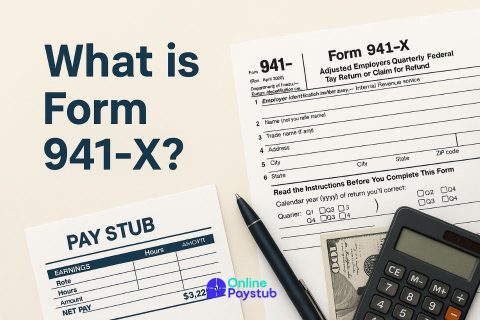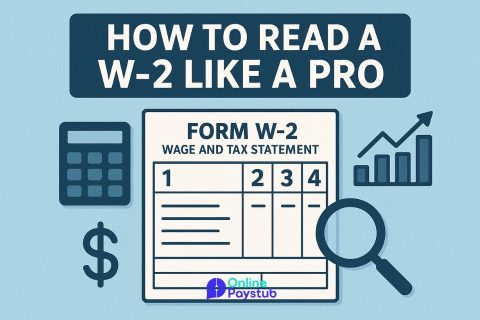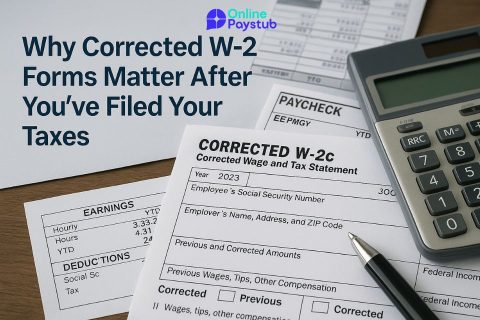Tax withholding refers to the portion of an employee’s earnings that an employer retains and submits directly to the IRS to cover the employee’s estimated annual tax liability. This process ensures that income taxes are paid progressively throughout the year, rather than in one lump sum at the end.
Employers determine how much to withhold based on the employee’s completed W-4 form. This form captures essential details such as filing status, dependents, and any additional amounts the employee opts to withhold. Based on that information, payroll systems apply federal withholding tables to calculate the amount deducted from each paycheck.
For example, if an individual earns $4,000 in gross monthly wages and their W-4 form indicates a standard withholding without additional amounts, the employer may withhold around $500 for federal income tax. This amount is forwarded to the IRS and tracked against the individual’s total tax liability for the year.
Tax withholdings are not limited to federal income tax. Depending on the employee’s location and circumstances, state income tax, local taxes, and even Social Security and Medicare taxes may also be withheld as part of the broader payroll deduction structure.
Proper withholding helps prevent underpayment penalties and reduces the likelihood of owing a large sum during tax season. Conversely, excessive withholding often results in a tax refund, indicating that more tax was paid throughout the year than was necessary.
How Are Tax Withholdings Different From Deductions?
Tax withholdings and tax deductions serve entirely different purposes within the tax system, though both impact the final amount of tax an individual owes.
Withholding refers to the income tax an employer deducts from an employee’s paycheck based on projected annual liability. This amount is submitted directly to the IRS throughout the year. It represents a prepayment of taxes, not a reduction in taxable income.
In contrast, deductions reduce the amount of income subject to tax. Rather than being taken from a paycheck, deductions are applied when filing an annual tax return. They lower the overall taxable income, which in turn reduces the tax owed. Common deductions include mortgage interest, student loan interest, and contributions to certain retirement accounts or health savings accounts.
An employee with consistent withholdings may still benefit from deductions when preparing a tax return. These deductions can reduce the final tax liability, potentially resulting in a refund if too much has been withheld.
While withholding operates automatically through payroll, deductions require documentation and must be claimed during the tax filing process. Misunderstanding the distinction can lead to errors in tax planning and inaccurate expectations regarding refunds or liabilities.
What Part of My Paycheck Goes to Federal Tax Withholding?
Federal tax withholding represents a specific portion of gross wages that is retained by an employer and remitted to the IRS on behalf of the employee. The exact amount withheld depends on several variables, including income level, filing status, allowances or dependents claimed on the W-4 form, and whether any additional withholding has been requested.
For salaried employees, the IRS provides withholding tables that employers use to determine how much to deduct each pay period. These tables are designed to approximate the total annual federal income tax an individual is expected to owe. The higher the income, the higher the percentage that may be withheld, particularly as one enters higher tax brackets.
Other payroll components such as Social Security and Medicare taxes are often withheld alongside federal income tax but serve different functions. It’s important to distinguish that only the federal income tax portion directly reduces annual income tax liability. Social Security and Medicare are separate obligations with their own contribution limits and rates.
For example, an individual earning $5,000 per month with no dependents and standard withholding settings might see $600 to $800 withheld for federal income taxes. Adjusting the W-4 form to reflect changes in life circumstances such as marriage, a second job, or having a child can affect that amount significantly.
Employees can review the exact amount withheld by examining their pay stubs or using IRS-provided tools such as the Tax Withholding Estimator. Keeping track of withholdings throughout the year is essential for aligning prepayments with actual tax liability.
How to Fill Out the W-4 Form for a Bigger Paycheck?
To increase your take-home pay through the W-4 form, follow these structured steps:
- Monitor Your Paycheck and Adjust as Needed
Use your pay stubs and IRS withholding estimator to confirm whether the changes are aligned with your goals. If needed, submit a revised W-4. - Review Your Current Tax Situation: Start by understanding your income level, filing status, number of dependents, and whether you have multiple jobs or a working spouse. This context will guide all entries on the form.
- Complete Step 1: Personal Information:Fill in your name, address, Social Security number, and filing status. Selecting “Single” or “Married filing separately” generally results in higher withholding than “Married filing jointly.”
- Skip Step 2 If You Have One Job: Step 2 is for multiple jobs or dual-income households. If this doesn’t apply, leave it blank. Incorrect use of this step can lead to excess withholding.
- Use Step 3 to Claim Dependents: If you have qualifying children or other dependents, enter the corresponding dollar amount. This reduces your estimated tax liability and increases your paycheck.
- Complete Step 4(a) Only If You Have Other Income
If you have non-wage income not subject to withholding (e.g., dividends or freelance work), report it here. Otherwise, leave it blank to avoid unnecessary withholding. - Leave Step 4(b) Blank Unless You Intend to Itemize Deductions
Most taxpayers use the standard deduction. Entering a number here unnecessarily can complicate your withholding. - Leave Step 4(c) Blank or Reduce the Extra Amount
If you previously entered an additional withholding amount, reducing or removing it will directly increase your paycheck. This step is optional but impactful.
Sign and Submit to Your Employer
Submit the completed form to your HR or payroll department. Changes typically reflect in your paycheck within one to two pay cycles.
Can Extra Withholding Help You Avoid IRS Surprises?
Extra withholding refers to the voluntary election to have an additional amount of federal income tax deducted from each paycheck. While this reduces net pay in the short term, it can be a strategic move for individuals who expect to owe more tax than standard withholding would cover.
This approach is particularly useful in the following scenarios:
- Earning significant non-wage income such as freelance work, investments, or rental income that isn’t subject to automatic withholding
- Having multiple jobs or a working spouse, which can distort withholding calculations
- Experiencing a change in tax status, such as losing eligibility for certain deductions or credits
- Owing tax in previous years and wanting to prevent recurrence
By increasing withholding throughout the year, taxpayers distribute their payments more evenly and reduce the risk of an underpayment penalty. The IRS generally expects individuals to pay at least 90% of their current-year tax liability or 100% of the prior year’s liability (110% for higher-income earners) to avoid penalties.
What If I Made a Mistake on My W-4 Form?
Mistakes on the W-4 form are common and often correctable without penalty, especially if addressed promptly. Since the form directly influences the amount of tax withheld from each paycheck, errors can result in either underpayment or overpayment of taxes throughout the year.
Common errors include:
- Selecting the wrong filing status
- Overstating or understating the number of dependents
- Failing to account for a second job or a spouse’s income
- Incorrectly entering additional withholding amounts
- Omitting other taxable income
If an error is discovered, the corrective action is to complete and submit a new W-4 form to the employer. Most payroll systems can process changes within one or two pay periods, allowing for timely adjustments.
Tax Withholding for Freelancers and Gig Workers: What’s Different?
Unlike traditional employees whose taxes are withheld automatically through payroll, freelancers and gig workers are typically responsible for managing their own tax obligations. This includes both income tax and self-employment tax, which covers Social Security and Medicare contributions.
The absence of employer-based withholding means that freelancers must estimate their annual tax liability and make quarterly payments directly to the IRS. Failure to do so can result in interest charges and penalties for underpayment.
The key distinctions in tax treatment include:
- No automatic withholding: Payments received from clients are made in full, with no tax deducted at the source.
- Estimated quarterly taxes: Individuals must calculate and submit payments four times a year using IRS Form 1040-ES.
- Self-employment tax liability: Freelancers are subject to an additional tax of 15.3% on net earnings, representing both the employee and employer portions of Social Security and Medicare contributions.
- Deductible business expenses: Qualified expenses such as equipment, software, home office use, and professional services can be deducted to reduce taxable income.
- Recordkeeping responsibility: Without employer-issued pay stubs or W-2 forms, freelancers must maintain their own records of income and expenses, often using 1099 forms issued by clients.
Some freelancers choose to mimic traditional withholding by setting aside a fixed percentage of each payment into a separate account, which can be used for tax payments. Others use tax planning tools or accounting software to automate calculations and payment schedules.
How to Estimate Your Tax Withholding Accurately?
Accurate tax withholding begins with understanding how current income, filing status, deductions, and tax credits affect total annual liability. Estimating withholding properly reduces the risk of both overpaying and underpaying taxes during the year.
The most practical method for achieving accurate withholding is to use the IRS Tax Withholding Estimator. This online tool incorporates multiple variables, including wage income, self-employment income, dependents, retirement contributions, and itemized deductions. The output provides a recommended withholding adjustment based on real-time inputs.
Key steps to improving withholding accuracy include:
- Gather income data
Review recent pay stubs, contract income, investment earnings, or any other taxable revenue. - Review filing status and dependents
Changes in marital status or number of dependents directly influence tax obligations and should be reflected in the W-4 form. - Account for other income sources
Include side jobs, freelance income, or capital gains. These are often overlooked and can lead to underpayment if not accounted for. - Adjust for deductions and credits
Factor in whether you’ll take the standard deduction or itemize. Consider education credits, childcare credits, and other applicable tax benefits. - Enter accurate withholding information into a calculator
Use the IRS estimator or trusted payroll calculators to determine whether current withholding aligns with expected tax liability. - Update the W-4 form if needed
If the estimation reveals a shortfall or overage, submit a revised W-4 to your employer. Adjusting the number of dependents or additional withholding fields can help fine-tune results. - Repeat the process mid-year
Withholding needs may shift due to job changes, raises, or life events. A mid-year check ensures continued alignment with tax obligations.
Consistent monitoring and periodic adjustments are necessary for taxpayers whose income fluctuates or whose financial situation changes throughout the year.




No comments to show.